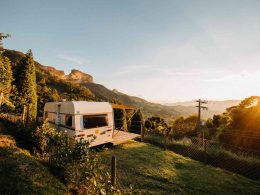Some families are comfortable driving four or five hours, while others don’t want to drive more than three. Some families find leaving early very difficult and stressful and prefer to leave later in the day. Thus, they travel shorter distances. Let’s take a look at some rules and tips you can use to guide your own decision.

How Far Should You Drive Your RV on Travel Day?
We’re going to take a closer look at two rules: the 2/2/2 rule and the 3/3/3 rule. Many RVers choose to follow one of these rules to help guide their traveling and planning. You don’t want to overdo it!
What Is the RVing 2/2/2 Rule?
Drive no more than 200 miles in one day. Stop every two hours for a stretch break. Arrive at the campground by 2 p.m. Stay at least two nights at the same campground. This is the 2/2/2 rule.
Why do some RVers follow this rule? First, it helps with planning. You know you’re only going to drive 200 miles (at most). You know you’re going to stay for two nights at the same campground (at least). For travelers who like to have a plan, following the 2/2/2 rule is actually freeing and not confining.
Second, it helps with fatigue. Most people can handle travel days following the 2/2/2 rule. You’re not exhausted once you arrive at a campground. Your family is happier, and it’s an overall more positive experience because you have placed limits on the amount of time you spend traveling.

Should You Follow a 2/2/2 or 3/3/3 Rule?
The 3/3/3 rule is essentially the same but with threes. Drive no more than 300 miles in one day. Stop every three hours for a stretch break. Arrive at the campground by 3 p.m. Stay at least three nights at the same campground. One rule isn’t better than the other. It’s a matter of personal preference.
Whichever you choose, just make sure everyone traveling with you is on board and understands the travel plan. If you have kids, they need to know that they have to be ready to go at a certain time so you can arrive at the next campground on time.
Do you want to travel more or less? Do you want to stay for longer periods or shorter? Unhitching and setting up is exhausting, so keep that in mind. You have to choose what’s best for your family.
Why Is Traveling in an RV More Exhausting Than a Car?
Driving a motorhome or towing a travel trailer is stressful and challenging. And that’s when everything goes perfectly. The driver has to be more focused. Accidents can be more dangerous and costly.
If you’re towing a vehicle behind your motorhome, you have to pay attention not only to the motorhome but the vehicle as well. And the same is true for drivers towing a travel trailer, fifth wheel, or toy hauler. You have to pay attention to two vehicles.
Traveling in an RV is also exhausting physically. Drivers can be tenser and thus need to take more breaks to stretch and walk around. This is a good reason to avoid driving in bad weather.

Tips to Set Your Travel Days up for Success
The best plans can still go wrong, so here are a few tips to have successful travel days. You may have a child wake up sick; you may get a flat tire. But if you can set yourself up for success, you have a better chance for a smooth travel day.
Prepare the Day Before
Whatever you can do the night before, do it. Pack up the toys, put away the loose dishes, put the outdoor gear in the storage bays. Then when you get up the next day, you won’t feel rushed.
Plan Your Gas and Food Stops
There are numerous apps available for travelers to help plan stops along your route. Utilize these resources! Depending on the rule you’re following, pay attention to drive time and distance and choose stops that fit in with your plan.
Also, pay attention to places that are easy to get in and out of with an RV. You may want to drive a mile off the interstate to park in a Cracker Barrel parking lot to eat lunch instead of trying to fit in the parking lot of a fast-food joint. Factor this into your time management and trip planning.
Hit the Road Early
Traveling in an RV takes longer than traveling in a car. Don’t count on arriving at the campground at the time your GPS predicts. If you head out early, you have time to stop for gas, lunch, or a stretch break. When you’re running behind, you’ll feel rushed and stressed. But the drive time will be pleasant and calm if you leave as early as you can.
And this allows for ample time to deal with problems. If you leave early and end up with a flat tire on the side of the interstate, you’re less likely to react impatiently. You’ll have time to handle the situation and still arrive at the next destination before dark.

Drive Slowly
You don’t have to drive the speed limit. It’s best not to drive the speed limit on interstates. You get better gas mileage, and it’s safer. This tip goes along with the previous tip. If you leave early, you aren’t in a rush, so you won’t be speeding down the road trying to arrive at your next destination by a certain time. You’re less stressed when you drive slowly, which means better attitudes all-around.
Try to Arrive at Camp Before Dark
Part of both the 2/2/2 rule and the 3/3/3 rule is arriving at your destination before dark. Actually, the goal is to arrive long before dark. But again, sometimes things go wrong, so it’s good to have a buffer.
It’s stressful and frustrating to try to set up camp in the dark, especially at a place you’ve never visited before. The kids may be tired and hungry; the dog may need to go for a walk. If you arrive at dark, the primary focus will be on getting set up quickly and not attending to the needs of your family. This can cause friction you could have avoided by arriving during the daytime.
Plus, if something goes wrong with the setup, you may have to wait until morning to resolve it. Campground offices and stores aren’t open, and hosts and rangers probably won’t be around.
Don’t Overdo It
If Plan A fails, take a deep breath and have a Plan B. Most of the time, you’ll travel safely and happily from one place to another. But there will be days where everything seems to go wrong. If you have to make an extra stop because someone needs to stretch and walk, do it. If a kid gets carsick and you need to stop and stay overnight somewhere, do it. Don’t try to beat the clock.
Avoid Traveling in Bad or Windy Weather
Start checking the weather a few days before your scheduled departure. You may want to head out a day early or stay a day later to avoid traveling in rough weather. Towing an RV in strong winds can be scary and nerve-wracking. This doesn’t lead to a pleasant travel experience. If you can change your plans to avoid heavy rain, storms, and wind, do it. Plus, hitching up and packing up in the rain starts the day off on the wrong foot.
The 2/2/2 rule and 3/3/3 rule are good suggestions to help with planning and preparation for travel days. Which one makes the most sense for your family? Whichever rule you choose, make sure to pay attention to the tips mentioned above. They can set you up for success.
If You Want the Latest Travel News, Join Our Mailing List
Don’t rely on biased RV industry news sources to keep you informed. Stick with Nomadic News. We publish articles and breaking stories that matter to you every weekday.










